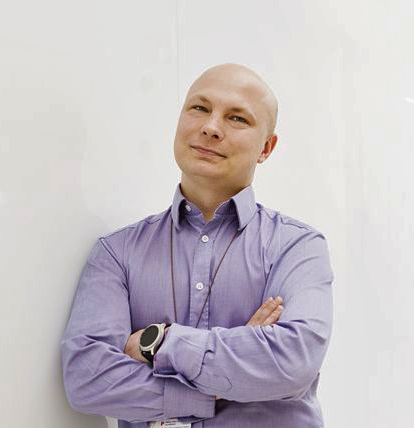Smarter Buildings with IoT
People are spending most of their time in offices, schools, and other public buildings, so understanding the well-being of not only the people but also the buildings themselves has become more and more important. Digitisation and IoT help us understand our surroundings and ISS is one of the pioneers in developing smart buildings. Jari Tiirikainen, ISS Head of Digital Excellence in Finland opens up the process of turning buildings smart with the help of IoT.
“Understanding the need for progress and development is step number one,” says Jari Tiirikainen. He directs his advice to the management of any corporation currently considering a digitization project. “The will for change must come from the management – but what will change? That must come from the operative side of the business”. The main purpose of IoT and digitisation projects is to make things easier for everyone and let’s face it – most people work in the operative sector.
What to pursue with your IoT project
We could easily overwhelm ourselves with the amount of data IoT can offer, but instead of quantity we want to go for quality. Digitization is all about creating a better organizational ecosystem and making processes more agile – with the help of 24/7 data. “We like to think the buildings are there for the people, not vice versa. Our slogan ‘People make places’ underlines this philosophy”, says Tiirikainen. His advice for getting the most bang for your buck is to find the factors that affect the agility and overall well-being of your employees the most and start improving them first.
Easier said than done? We know such a leap can’t be done overnight, but rather in a step-by-step process that involves multiple aspects and departments in your organization. Building the ecosystem for your digitization project and utilizing the network efficiently requires a solution architect who can put the pieces of the puzzle together. Now the real question is, which pieces to use? “Nowadays there isn’t a single project that doesn’t involve IT”, Tiirikainen states. “But what’s more important than IT is involving the end users in the project”, he continues. Having a state-of-the-art solution that does not serve the needs of the end-users 100% is better left undone because, in the end, it will not be as agile or useful as intended if the key people don’t feel comfortable with it. To sum it up, you will have to figure out your network of departments involved in the project, find the right people from each department, and get the end users committed. That’s how you get started, but running through the project is another story.

You have to be agile to become agile
When you’re working your fingers to the bone to become an agile business, you need a certain mindset during the process, too. Involving end users from early on helps you find possible issues while building the concept, which is exactly what you want. Iterations are way easier than fixing something in a finished concept! “We encourage our people to take part in the project and try to find possible faults in the system before we progress any further”, says Jari Tiirikainen. “It’s difficult to see those tiny impracticalities from the ivory tower, so it’s better to work from the ground up with the help of your end users”.
Bear in mind that every project will probably spark new projects, too. It may happen through iterations or after finishing your first project, but trust us – it will not be the only one after you see the benefits. Tiirikainen, who has been working in business development for the past 15 years, has valuable insight: “Especially in the estate and construction business the digitization journey has just begun! We keep finding new opportunities all the time by measuring and monitoring different variables and while we gain more knowledge and evidence, there are always more questions, too”, he explains.

Time to implement!
We hate to break it to you, but there’s no one-size-fits-all solution for the implementation phase. Every organization, every ecosystem, and every project is different, so there’s a lot you need to take into account before implementing your brand-new solution. ISS has an impressive track record in successful IoT projects, but what’s their secret? “Because implementation is such a demanding process, you need to have a structured operating model for it. In our case, the working committee simply cannot train hundreds of people in a reasonable timespan, so we put a lot of work into creating high-quality training materials and building an implementation chain that covers the entire organization”, Head of Digital Excellence Tiirikainen reveals. Now, if you are reading this, you have probably realized running a digitization project has more to it than just plugging in some gadgets and crunching numbers of the data they collect.
Don’t be upset if your first project doesn’t feel like a walk in the park. Even someone like Jari Tiirikainen has seen a bunch of projects that didn’t go as planned or even failed. That’s called learning. You will have to look back at every project and inspect every phase of it. What went well? What didn’t go that well? Where did you encounter problems? Was the end result satisfying? If you are starting your first-ever digitization project, don’t hesitate to use an experienced consultant or partner to get you started.
Did we succeed?
It may take months or even years to see the actual benefits of all the hard work you put into your digitization project. We asked Jari Tiirikainen, a seasoned veteran in digitization and business development, for the best cues of a successful project: “It’s when someone comes to me and says ‘thank you, this has been really helpful’ that really makes me feel like we did a good job. After all, making people’s lives easier is the main objective of every digitization project”. Seeing your end users adopt the new system with pleasure is indeed what you should’ve been aiming for in the first place. Remember, technology is there to make our lives easier!
Understanding the need for progress and development is step number one. The will for change must come from the management – but what will change? That must come from the operative side of the business.
Jari Tiirikainen, Head of Digital Excellence, ISS Finland
This article is a part of a series about starting with IoT solutions. Read the other articles here:


